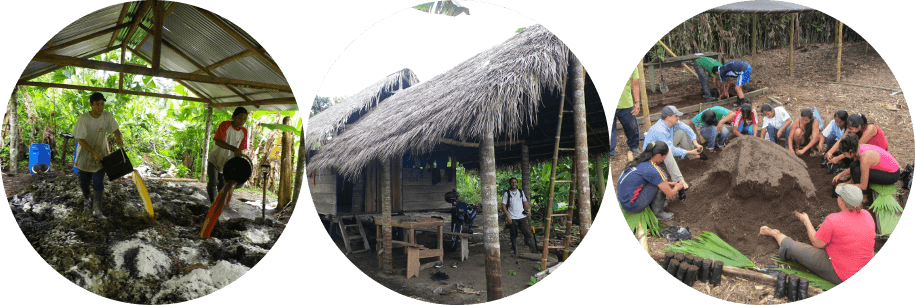
#1 A privileged place for training and education
Since 2009, the Ishpingo association owns a farm located in the Talag area. This farm is now used for educational purposes. It allows us to :
1 – improve the level of education for reforestation of the local population.
2 – contribute to preservation of the botanical heritage of the Amazon.
3 – conduct scientific programs in agroforestry.
This farm includes 6 hectares of agricultural land and 5 hectares of virgin forest.
We built there a hut for theorical training, a small warehouse to store our working tools and a sheltered space that allows us to produce organic fertilizer.
Since 2010, 4,000 trees (fruit species as well as timber species) have been planted according to several different agroforestry systems.
Associated crops, tree species, distribution, density and distance between each plant do vary for each agroforestry model we use.
We measure regularly the growth of the plants as well as the mortality rate in order to be able to compare the models between them.
Since 2013, we have invited all farmers who participate in our projects to hands-on training.
They can observe our agroforestry practices and check the way we allocate tree species on plots. The purpose is to make them able to reproduce those techniques in their own farm.
Some fruit trees are now mature. The tasting of unknown fruits is a subtle way to give the farmers extra motivation to reforest their plots.

#2 The tree nursery of Ishpingo
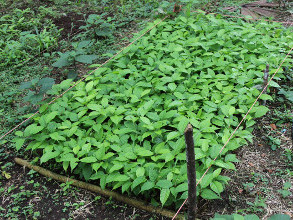 Our farm also includes a tree nursery which offers a production capacity of 10,000 plants per year.
Our farm also includes a tree nursery which offers a production capacity of 10,000 plants per year.
This volume of production allows us to :
1 – support other community nurseries in the vicinity that are aften under-supplied.
2 – distribute more seedlings to farmers who want to plant more trees than initally expected.
We also use this tree nursery to germinate in a seedbad the seeds we bought or gathered within the forest.
#3 Organic fertilizer production
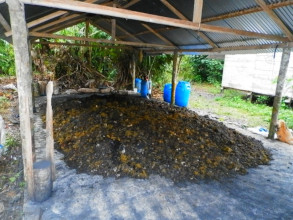 Since 2015, we have been developing our own high quality organic fertilizer called « Bokashi ».
Since 2015, we have been developing our own high quality organic fertilizer called « Bokashi ».
The preparation process we use is derived from an ancient Japanese technique. The Boskashi is composed of organic elements (manure, coffee pulp, carbon) and many microorganisms that will sustainably enrich the soil. The combination of these elements improves the physical and chemical conditions of the soil, prevents diseases, provides necessary nutrient for proper crops development in order to get vigorous high-yield plants without resorting to chemicals.
The microorganisms inserted in our formula are extremely important. Naturally present within ecosystems, they offer benefical properties that « activate the soil », keep it alive and capable of producing these nutrients by itself. Yeasts, actinomycetes, lactic acid and photosynthetic bacteria are some of those microorganisms we are speaking about. They are at the root of complex soil ecosystems and create a connection between soil-plant and soil-soil systems.
To produce Bokashi we must go within the forest to collect decomposed fallen leaves that are covered with whitish mushrooms. Through a fermentation process, microorganisms multiply. When the concentration is sufficient, we can use them to create foliar and Bokashi fertilizers.
Part of our production is distributed to farmers to spread their fruit tree plantations. The other part is used for our experiments in the nursery or on our plots.
#4 Seed bank in vivo
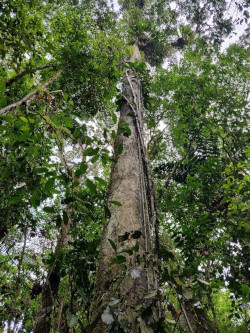 The farm of Ishpingo shelters 50 different species of timber and 50 different species of fruit trees.
The farm of Ishpingo shelters 50 different species of timber and 50 different species of fruit trees.
The seeds at the origin of these trees were selected on mother trees presenting optimal qualities.
For timber species we favor tall trees with straight trunk while for fruit species we prefer small trees that procude a large amount fruit and present disease resistance properties.
Some of our fruit trees have already entered the production phase. This is important to notice it sinc now we can gather and use their seeds to continue reforestation with reliable trees.
This practice allows us to fill out our seed bank. In the long term this will greatly facilitate our reforestation actions since seeking mother trees within the forest will no longer be necessary. You may not realize it, but it’s hard work, time-consuming and sometimes leads to no results.
#5 An experimental platform
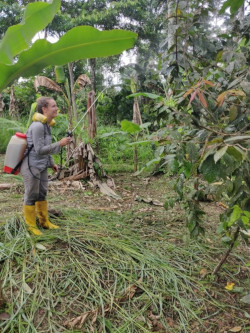 Since the creation of the first experimental agroforestry plots, a regular monitoring of the evolution of plantations has always been carried out.
Since the creation of the first experimental agroforestry plots, a regular monitoring of the evolution of plantations has always been carried out.
We check the behavior of each species individually according to different parameters such as shading, soil type, the use or not fertilizers, grassing and pruning trees.
We also watch closely the interactions between the specieson the same plot : species that are compatible or not to coexist on the area space according to the amount of shading provided by on specie on another, the fall of branches affecting smaller species, the competition for light, for space at the root level and for the nutrients of the soil, finally insect hosting capacity which can be beneficial or harmful for one or other of the species.
The Ishpingo Farm is a place where you can test and experiment with plots maintenance techniques, with natural and local solutions to fight against pests, invasive plants and other fungi that may harm farmers’ crops.
These solutions can be mechanical or by spreading organic mixtures directly on the trees or at their foot.
